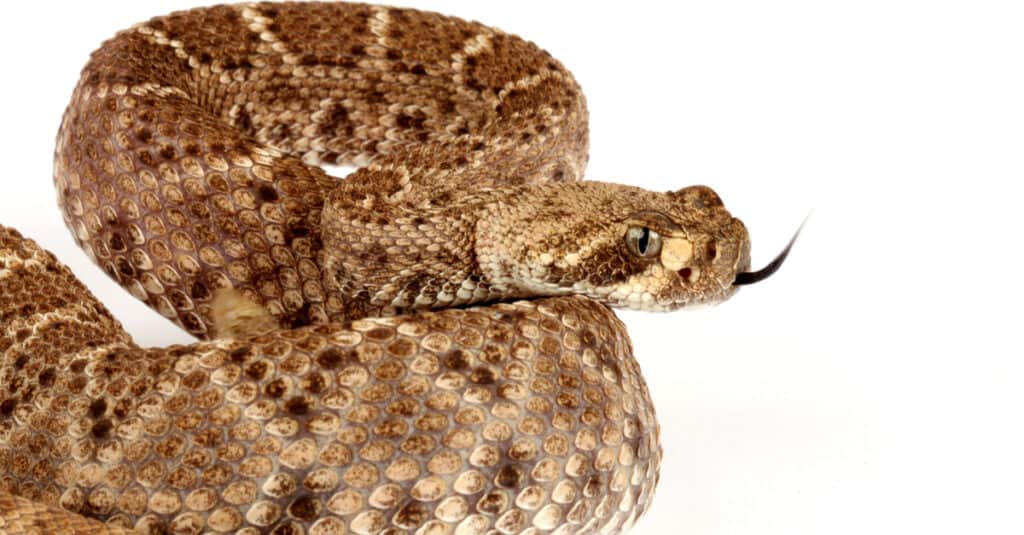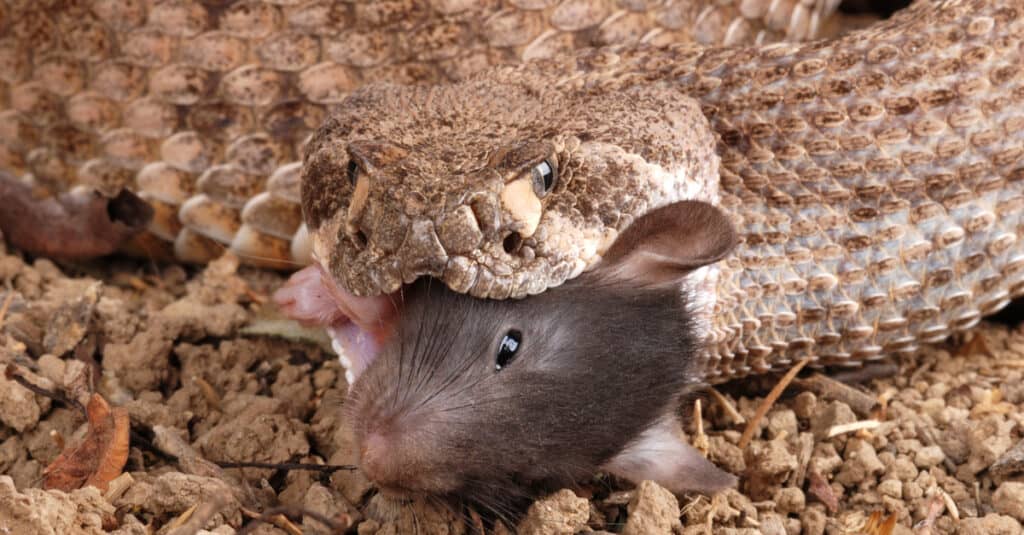Western Diamondback Rattlesnake
.jumbotron {
background-image: url(“https://a-z-animals.com/media/2022/03/crotalus-atrox-diamondback-shutterstock_246331870-400×300.jpg”);
}
}
@media only screen and (min-width: 641px) and (max-width: 920px) {
.jumbotron {
background-image: url(“https://a-z-animals.com/media/2022/03/crotalus-atrox-diamondback-shutterstock_246331870-470×370.jpg”);
}
}
@media only screen and (min-width: 921px) {
.jumbotron {
background-image: url(“https://a-z-animals.com/media/2022/03/crotalus-atrox-diamondback-shutterstock_246331870.jpg”);
}
}
Western Diamondback Rattlesnake
C. atrox
They replace their fangs 2-4 times per year!
Western Diamondback Rattlesnake Scientific Classification
- Kingdom
- Animalia
- Phylum
- Chordata
- Class
- Reptilia
- Order
- Squamata
- Family
- Viperidae
- Genus
- Crotalus
- Scientific Name
- C. atrox
Read our Complete Guide to Classification of Animals.
Western Diamondback Rattlesnake Conservation Status
Western Diamondback Rattlesnake Facts
- Prey
- small mammals
- Name Of Young
- neonate
- Group Behavior
-
- Solitary
- Fun Fact
- They replace their fangs 2-4 times per year!
- Biggest Threat
- Habitat destruction
- Most Distinctive Feature
- Rattle and black/white banded tail.
- Distinctive Feature
- Large, spade-shaped head and diamond-shaped markings on their back.
- Other Name(s)
- Western diamond-backed rattlesnake, adobe snake, Arizona diamond rattlesnake, coon tail, desert diamond-back, desert diamond rattlesnake, fierce rattlesnake, spitting rattlesnake, buzz tail, Texan rattlesnake, Texas diamond-back, and Texas rattler.
- Gestation Period
- 165 days
- Litter Size
- 10-20
- Diet
- Carnivore
- Lifestyle
-
- Nocturnal
- Diurnal
- Crepuscular
- or Nocturnal Depending on Region and Season
- terrestrial
- Common Name
- Diamondback Rattler
This post may contain affiliate links to our partners like Chewy, Amazon, and others. Purchasing through these helps us further the A-Z Animals mission to educate about the world’s species..

Discover alligator-eating snakes, spiders larger than your phone, and 1000 more incredible animals in our daily FREE email.
.photo-gallery {
–margin: 0px auto 0px;
–padding: 0px 0px 0px 0px;
}
.gallery-link {
background-image: url(“https://a-z-animals.com/media/2022/03/crotalus-atrox-diamondback-shutterstock_78274441-1024×535.jpg”);
background-repeat: no-repeat;
background-size: cover;
background-position: center;
height: 500px;
justify-content: center;
text-align: center;
align-items: center;
display: flex;
border: 2px solid #000;
}
.gallery-link img {
height: 50%;
}
@media only screen and (max-width: 768px) {
.gallery-link {
height: 300px !important;
}
}
View all of the Western Diamondback Rattlesnake images!
Western diamondback rattlesnakes are an icon of the west.
Featured in many movies, the sound of a rattlesnake is unmistakable. It’s also disturbing if you grew up in an area where you share nature with them. They’re long and heavy-bodied venomous snakes, the second-longest in North America. These snakes are reclusive and avoid people in any way they can, but bites are common because they’re common in their territory.
4 Amazing Facts About Western Diamondback Rattlesnakes
- They are the second-longest venomous snake in North America; only the eastern diamondback rattlesnake is the longest.
- You can’t count their age by their rattles; not only do they break, but western diamondback rattlesnakes can shed more than once per year.
- They can regrow their fangs several times per year.
- Males grow much larger than females and fight for the right to mate with receptive females.
Where to Find Western Diamondback Rattlesnakes
Western diamondback rattlesnakes inhabit the southwestern United States and northern Mexico. They prefer living in arid desert and semi-desert conditions; they are often found hiding under vegetation or other cover items, such as rocks, branches, and debris.
button.pulse {
transform: scale(1); animation: pulse 2s infinite;
box-shadow: 0 0 0 0 rgba(11, 247, 25, 1);
}
@keyframes pulse {
0% { transform: scale(0.90); box-shadow: 0 0 0 0 rgba(11, 247, 25, 0.5); }
60% { transform: scale(1); box-shadow: 0 0 0 15px rgba(11, 247, 25, 0); }
100% { transform: scale(0.90); box-shadow: 0 0 0 0 rgba(11, 247, 25, 0); }
}
Some members of this species migrate one to two miles to and from communal dens in the spring and fall. In the spring, males often fight for dominance and breeding rights. However, the snakes don’t generally injure one another during these impressive displays.
Like many vipers, western diamondback rattlesnakes are born rather than hatched. About 165 days after mating, the female gives birth to 10-20 babies, called neonates. Within a couple of hours, they head off on their own to find shelter and food. Most neonates don’t survive their first year because they’re heavily preyed upon by other species.
Western Diamondback Rattlesnake: Scientific Name
Their scientific name, Crotalus atrox, means “horrible rattle.” Crotalus originates in Greek and means rattle, while atrox is the Latin root for our English root of “atrocious.”
Western diamondback rattlesnakes are part of the Viperidae family; and are pit vipers from the Crotalinae subfamily. They have several common names, including coon tail, buzz tail, and rattler.
Types of Diamondback Rattlesnake
Diamondback rattlesnakes get their name from their diamond-shaped markings and tail rattle. They inhabit southern portions of the United States and northern Mexico.
- Western Diamondback Rattlesnake (Crotalus atrox) occurs in the southwest United States and northern Mexico.
- Eastern Diamondback Rattlesnake (Crotalus adamanteus) lives in the southeast United States primarily Florida and Alabama.
- Red Diamondback Rattlesnake (Crotalus ruber) has three recognized subspecies, Cedros Island red diamond rattlesnake (C. r. exsul), San Lucan red diamond rattlesnake (C. r. lucasensis), and the red diamond rattlesnake (C. r. ruber). They inhabit the southwestern corner of California south to the tip of Baja California, and a few Gulf and Pacific islands near the coast.
Population and Conservation Status of Western Diamondback Rattlesnakes
Western diamondbacks aren’t endangered. They thrive in the desert southwest and have a stable population. In 2007, the IUCN assessed them for inclusion on IUCN the Redlist and listed them as Least Concern.
However, rattlesnake roundups still occur in some areas where people gather and kill as many as possible. This unfortunate practice throws local ecosystems out of balance with a dramatic loss of many predators at one time.
These snakes face several threats, including habitat destruction and predation. Many animals prey on juvenile and adult western diamondback rattlesnakes, including hawks, roadrunners, wild hogs, owls, king snakes, Texas indigo snakes (expert rattlesnake hunters), and coachwhip snakes.
Appearance and Description: Identifying the Western Diamondback Rattlesnake
These thick-bodied rattlesnakes measure about two feet long when they’re born. Western diamondback rattlesnakes often reach four feet long, but individuals five and six feet long occur occasionally. The longest on record was seven feet long. They’re relatively heavy and typically weigh between three and six pounds; very heavy individuals can weigh 15 pounds.
Most of them have a tan to a grayish background color, but some are pinkish, red, or orange. Over their base color, darker blotches extend down the length of their back. These start somewhat rectangular and become diamond-shaped further down the back.
They have a stripe running diagonally down their head, starting just below their eye. Western diamondback rattlesnakes have elliptical pupils and a scale that sits over the top of their eyes. This scale is present on many viper species and lends to the “angry expression” that many people feel they exhibit.
Western diamondback rattlesnakes have strongly keeled scales that make them look dull instead of shiny. They have large, spade-shaped heads that are twice the width of their neck, and their tails have alternating black and white or gray bands that end in rattles.

Audrey Snider-Bell/Shutterstock.com
Western Diamondback Rattlesnake: Pictures and Videos

Audrey Snider-Bell/Shutterstock.com

Audrey Snider-Bell/Shutterstock.com

Audrey Snider-Bell/Shutterstock.com
Venom: How Dangerous are Western Diamondback Rattlesnakes
As with other rattlesnake species, western diamondbacks only strike for defense and potential food. Left alone, these are reclusive animals that avoid people. Bites happen because it felt threatened, or that person antagonized it.
The venom of most diamondback rattlesnake species tends to be less toxic than that of other rattlesnake species. However, they can inject large amounts into victims, making their bites quite dangerous.
According to DovMed, western diamondback rattlesnake venom is “hemotoxic, myotoxic, and cytotoxic, affecting the blood and heart system and the body muscles. ” Their venom may have components that help them digest their food, so they prefer saving venom for prey animals.
Western Diamondback Rattlesnakes: Behavior and Humans
These snakes’ diet includes small mammals, including mice, woodrats, rabbits, squirrels, and occasionally birds and lizards. They’re primarily nocturnal and use heat-sensing pits between their nostrils and eyes to locate prey. During the cooler spring months, they’re active more often throughout the day, but they’re only active at night during the summer. To hunt, western diamondback rattlesnakes tuck themselves into a good hiding spot and wait for their meal to come to them. A 1976 study that followed their eating habits indicated that the bulk of their diet is small mammals.
Western diamondback snakes are not aggressive in that they won’t be chasing you down. However, they stand their ground when cornered—the distinctive rattle signaling their displeasure with your presence. They don’t always rattle a warning. Sometimes they stay quiet and try to keep hidden. They’re a little feistier than other snakes and more willing to bite. Generally, they’re happy to get away from you if you back away slowly to give them space.
View all 74 animals that start with W
Western Diamondback Rattlesnake FAQs (Frequently Asked Questions)
Are western diamondback rattlesnakes venomous?
Yes. Eastern and Western diamondback snakes cause most of the venomous snakebites in the United States each year. They inject a large amount of venom in one bite, which requires immediate medical care to treat.
How do western diamondback rattlesnakes hunt?
These are ambush predators. They’re also lousy climbers, so they lie in wait for their meals.
Are western diamondback rattlesnakes aggressive?
Not really, but they stand their ground when cornered, and they’re more likely to bite when they’re frightened.
Where do western diamondback rattlesnakes live?
These are some of the most widespread of the diamondback rattlers. They live in the desert southwest and forested areas. You’ll find them in California, Arizona, New Mexico, Texas, Arkansas, Oklahoma, and northern Mexico. They also occasionally occur in Kansas.
What do western diamondback rattlesnakes eat?
Like most larger snakes, they are your somewhat prickly wild area rodent control. They eat rabbits, rats, mice, ground squirrels, sometimes birds, and neonates also eat lizards.
Sources
- Food Habits of the Western Diamondback Rattlesnake in Texas, Available here: https://www.jstor.org/stable/3669867
- Nevada Dept. of Wildlife, Available here: https://www.ndow.org/species/western-diamondback-rattlesnake/
- Western Diamondback Rattlesnake Bite | DovMed, Available here: https://www.dovemed.com/diseases-conditions/western-diamondback-rattlesnake-bite/
- Reptile Database, Available here: https://reptile-database.reptarium.cz/species?genus=Crotalus&species=atrox
















